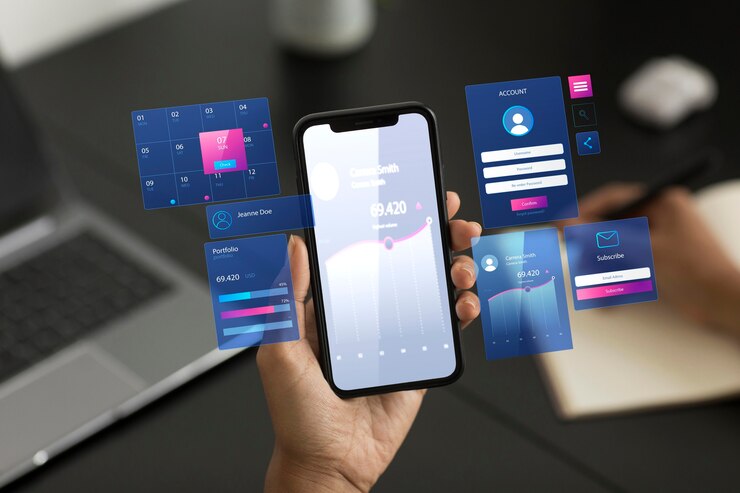Apple’s iOS platform continues to be at the forefront of innovation as the mobile app market continues to grow at an accelerated rate. With 2.2 million apps available in the App Store and over 1.2 billion iPhone users globally, iOS app developers have a special chance to create apps that are used by millions of people.
Thanks to advancing technology and shifting consumer tastes, 2024 will see a significant change in the trends around iOS app development. For developers hoping to keep their competitive advantage and provide excellent user experiences, staying ahead of these trends is essential. We’ll examine the most innovative trends in iOS app evelopment that will influence mobile apps in 2024 and beyond in this extensive blog.
1. AI and Machine Learning Integration
Machine learning (ML) and artificial intelligence (AI) have evolved to be even more crucial to the creation of mobile apps by 2024. Developers may now more easily incorporate AI-driven functionality into apps thanks to Apple’s introduction of robust tools like Core ML and Create ML. Siri, facial recognition, and even predictive text in messaging apps are now mostly powered by AI and ML.
Key Use Cases:
- Smart Assistants: AI-powered personal assistants that learn user preferences and behaviors, offering personalized recommendations.
- Image Recognition: Core ML allows apps to recognize objects, faces, and gestures in real-time, boosting functionalities in e-commerce and social media apps.
- Natural Language Processing: Integrating NLP into apps enables improved voice search, sentiment analysis, and chatbots.
Stats and Facts:
- According to Statista, the global AI market is expected to reach $190.61 billion by 2025.
- iOS apps developement with AI-powered features are predicted to have a 30% faster growth rate compared to non-AI apps in 2024.
2. Augmented Reality (AR) and Virtual Reality (VR)
Apple is spearheading the revolution in mobile application interaction through ARKit 5, a platform that combines virtual reality (VR) and augmented reality (AR). These technologies are becoming widely adopted in a variety of areas, including retail, healthcare, education, and real estate. They are no longer just used in games and entertainment.
Key Use Cases:
- Retail: AR allows users to visualize products in their environments before making a purchase.
- Healthcare: VR can be used for training medical professionals or helping patients with mental health treatments.
- Education: AR and VR create immersive learning experiences that engage students more effectively.
Stats and Facts:
- The global AR and VR market is expected to reach $161.1 billion by 2024 (IDC).
- Over 1 billion AR-enabled devices are projected to be in use by 2024, with the majority being iOS devices thanks to ARKit.
3. Swift 6: The Future of iOS Development
Swift, Apple’s potent programming language, is still developing in 2024; its most recent version, Swift 6, is influencing iOS app development. Swift 6 prioritizes concurrency, performance, and safety, making it possible for developers to create apps more quickly and effectively. Better support for asynchronous programming, which is essential for contemporary mobile applications, is also introduced by the language.
Key Features of Swift 6:
- Improved Memory Management: Swift 6 offers developers more control over memory, leading to more efficient apps that consume fewer resources.
- Asynchronous Programming: Developers can now handle tasks like API calls more efficiently without affecting app performance.
- Cross-Platform Support: Swift 6 enhances its cross-platform capabilities, making it easier to port iOS apps to other Apple devices such as macOS and watchOS.
Stats and Facts:
- Swift is currently the 6th most popular programming language globally (TIOBE Index).
- Over 75% of iOS apps are now built using Swift, making it the go-to language for Apple development.
4. Focus on Privacy and Security
Security and privacy have always been top priorities when developing mobile apps, and iOS apps have to follow strict requirements because of Apple’s dedication to user privacy. As customers seek greater control over their data, privacy-first app development is expected to be a major trend in 2024. Developers are required under Apple’s App Privacy Labels and App Tracking Transparency (ATT) architecture to obtain explicit user consent for tracking and to disclose data collecting practices.
Key Privacy Enhancements:
- Private Relay: A new feature in iCloud that hides users’ IP addresses, ensuring they can browse safely and privately.
- Mail Privacy Protection: Prevents senders from knowing when an email is opened or the IP address of the recipient.
- ATT Framework: Apps must request permission from users before tracking their activities across other apps or websites.
Stats and Facts:
- A 2024 survey revealed that 85% of iPhone users are concerned about how their data is collected and used by apps.
- 48% of users are more likely to download apps that clearly state their privacy practices (Forrester Research).
5. 5G Technology: Faster and More Reliable Apps
iOS developers now have the chance to create apps that are quicker to launch and more responsive as 5G networks spread over the globe. With 5G’s incredibly low latency and fast connectivity, developers may build apps with more features like enhanced augmented reality, gaming, and real-time streaming. Using 5G will be a key component in developing iOS apps in 2024.
Key Use Cases:
- Enhanced Streaming: High-definition video streaming with minimal buffering and reduced loading times.
- Real-time Collaboration: Apps can support real-time collaboration features, especially in gaming, social media, and business tools.
- Instant Data Syncing: Faster data syncing between devices and servers, improving the overall user experience in cloud-based apps.
Stats and Facts:
- 5G network coverage is expected to reach 60% of the global population by 2025 (GSMA).
- iOS apps optimized for 5G networks are expected to see a 25% increase in performance compared to 4G apps.
6. Wearable Technology and Integration with iOS Apps
An essential component of the iOS environment are wearables, like the Apple Watch. By 2024, wearables and iOS apps will be seamlessly integrated, providing users with a smooth experience across all platforms. Multi-device app development will be fueled by wearable tech integration, which will extend to smart home controls and health tracking.
Key Use Cases:
- Health and Fitness: Integration with Apple Watch to monitor health metrics like heart rate, steps, and calories burned.
- Home Automation: Apps can connect with wearables to control smart home devices like lighting, security systems, and thermostats.
- Payments: Wearable integration allows users to make contactless payments through Apple Pay.
Stats and Facts:
- The global wearable technology market is projected to reach $265.4 billion by 2026 (Statista).
- In 2024, over 50 million Apple Watches are expected to be in use, making it the most popular wearable device.
7. Cross-Platform Development with Swift UI
SwiftUI is gaining popularity as a framework that lets programmers create cross-platform applications from a single codebase. In 2024, developers will find it easier to create apps for iOS, macOS, watchOS, and tvOS thanks to SwiftUI’s improved features. This guarantees uniformity across various Apple devices while cutting down on development time and expenses.
Key Features of Swift UI:
- Declarative Syntax: Allows for faster and more readable code, reducing the likelihood of bugs.
- Dynamic Previews: Developers can instantly see how their app will look on different devices without needing to compile the code.
- Improved Cross-Device Compatibility: SwiftUI makes it easier to port apps from iOS to macOS or even the Apple Watch.
Stats and Facts:
- Over 35% of new iOS apps are now developed using SwiftUI, with that number expected to grow significantly by the end of 2024.
Conclusion
In 2024, there will be a more vibrant and dynamic iOS app development scene than there has been previously. Developers now have an abundance of tools at their disposal to create cutting-edge mobile apps because to improvements in AI, AR, Swift, 5G, and wearable technologies. However, staying on top of these changes calls for knowledge and a proactive mindset.

